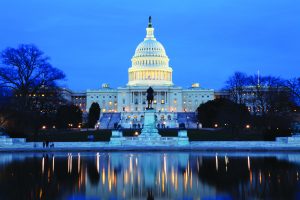In “Understanding Capitol Hill and the Federal Appropriations Process,” the Strategies 360 federal relations team outlined three phases of advocacy: conducting outreach (October-February), submitting your request (January-March/April), and monitoring your request (April-September). While the timeline of advocacy activities remains the same regardless of whether appropriations bills are passed on time, Congress’s frequent use of short-term spending bills (“continuing resolutions”) to avoid a government shutdown may negatively impact your organization. Namely, continuing resolutions (CRs) prohibit the initiation of new activities that were not funded in the previous fiscal year, thereby causing costly delays to planned projects.
Here, we explain the fiscal year (FY) 2020 appropriations and the two CRs that extended the appropriations deadline to December 20, 2019.
The Appropriations Process
The appropriations process is completed when all 12 appropriations bills are enacted. The 12 appropriations bills are produced from each of the 12 appropriations subcommittees (identical in the House and Senate):
- Agriculture, Rural Development, Food and Drug Administration, and Related Agencies
- Commerce, Justice, Science, and Related Agencies
- Defense
- Energy and Water Development
- Financial Services and General Government
- Homeland Security
- Interior, Environment, and Related Agencies
- Labor, Health and Human Services, Education, and Related Agencies
- Legislative Branch
- Military Construction, Veterans Affairs, and Related Agencies
- State, Foreign Operations, and Related Agencies
- Transportation, Housing and Development, and Related Agencies
If the bills are enacted on time (prior to October 1st), then it is considered “regular appropriations.” However, “regular appropriatons” has not happened since FY1997.[1] It is more common for Congress to pass a portion of the 12 appropriations bills on time and get an extension on the remaining, and perhaps more controversial, bills. In FY2020, all 12 appropriations bills did not pass on time and the October 1st deadline was extended to December 20th through two CRs.
The 12 appropriations bills can be considered individually, in smaller packages called “minibuses,” or in a complete package called an “omnibus.” FY2020 appropriations were completed with two consolidated appropriations bills or “minibuses”: H.R. 1158 (“national security appropriations minibus”) and H.R. 1865 (“domestic priorities and international assistance appropriations minibus”). Appropriations packages are also attractive vehicles for unrelated and sometimes controversial legislative provisions, because they are viewed as must-pass measures to prevent a government shutdown.
FY2020
For FY2020, Congress passed two CRs to extend the October 1st deadline for all 12 appropriations bills to November 21, 2019 and then to December 20, 2019. During this period, funding levels were maintained at the FY2019 funding rate. As previously stated, the funds could only be used for activities funded in FY2019 and not for “new start” projects.
On December 16, 2019, two appropriations packages containing all 12 appropriations bills were introduced, and Congress passed the two package deals prior to the December 20th deadline. The first package, H.R. 1158, contained appropriations bills for Department of Defense; Commerce, Justice, Science, and Related Agencies; Financial Services and General Government; and Homeland Security. The second package, H.R. 1865, contained appropriations bills for Labor, Health and Human Services, Education, and Related Agencies; Agriculture, Rural Development, Food and Drug Administration, and Related Agencies; Energy and Water Development; Interior, Environment, and Related Agencies; Legislative Branch; Military Construction, Veterans Affairs, and Related Agencies; State, Foreign Operations, and Related Programs; and Transportation, Housing and Urban Development, and Related Agencies.
The FY2020 spending bills totaled $1.4 trillion. Appropriations highlights include $25 million for gun violence research at the Center for Disease Control and National Institutes of Health; $1.375 billion for border security; and $425 million in election security grants. Policy highlights include raising the minimum smoking and vaping age to 21, and repealing three Obama-era taxes implemented under the Affordable Care Act (medical device excise tax, annual fee on health insurance providers, and excise tax on high cost employer-sponsored health coverage). For more information about the FY2020 appropriations bills, please visit https://www.appropriations.senate.gov/ and https://appropriations.house.gov/.
Working with your Strategies 360 Federal Team
S360’s Washington D.C. office is well equipped to support the firm’s clients navigating the appropriations process. They can cut through red tape and direct team members to the right offices and staffers at each phase of the appropriations process.
If you have any questions about the appropriations process, please feel free to contact Andy Winer (andyw@strategies360.com) or Serena Li (serenal@strategies360.com).
[1] Congressional Research Service, “Continuing Resolutions: Overview of Components and Practices,” Congressional Research Service, April 19, 2019, https://fas.org/sgp/crs/misc/R42647.pdf.
